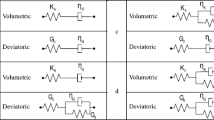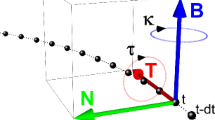Abstract
The use of the stretched-exponential function to represent both the relaxation function g(t)=(G(t)-G ∞)/(G 0-G ∞) and the retardation function r(t) = (J ∞+t/η-J(t))/(J ∞-J 0) of linear viscoelasticity for a given material is investigated. That is, if g(t) is given by exp (−(t/τ)β), can r(t) be represented as exp (−(t/λ)µ) for a linear viscoelastic fluid or solid? Here J(t) is the creep compliance, G(t) is the shear modulus, η is the viscosity (η−1 is finite for a fluid and zero for a solid), G ∞ is the equilibrium modulus G e for a solid or zero for a fluid, J ∞ is 1/G e for a solid or the steady-state recoverable compliance for a fluid, G 0= 1/J 0 is the instantaneous modulus, and t is the time. It is concluded that g(t) and r(t) cannot both exactly by stretched-exponential functions for a given material. Nevertheless, it is found that both g(t) and r(t) can be approximately represented by stretched-exponential functions for the special case of a fluid with exponents β=µ in the range 0.5 to 0.6, with the correspondence being very close with β=µ=0.5 and λ=2τ. Otherwise, the functions g(t) and r(t) differ, with the deviation being marked for solids. The possible application of a stretched-exponential to represent r(t) for a critical gel is discussed.
Similar content being viewed by others
References
Andrade ENdaC (1910) The viscous flow in metals, and allied phenomena. Proc Roy Soc A 84:1–15
Andrade ENdaC (1947) Viscosity and plasticity. W Hefter & Sons, Ltd, Cambridge
Andrade ENdaC (1962) The validity of the t 1/3 law of flow of metals. Phil Mag (Ser 8)7:2003–2014
Berry GC (1976) The stress-strain behavior of materials exhibiting Andrade creep. Polym Eng Sci 16:777–781, and references cited therein
Berry GC (1976) Thermal-mechanical studies on a heterocyclic polymer. I. Tensile creep and recovery. J Polym Sci: Polym Phys Ed 14:451–478
Berry GC, Plazek DJ (1986) Rheology of polymeric fluids. In: Glass: Science and Technology. Uhlmann NJ, Kreidl DR (eds), Academic Press, Inc., New York, Vol 3: Viscosity and Relaxation, pp 319–362
Cole KS, Cole RH (1942) Dispersion and absorption in dielectrics. II. Direct-current characteristics. J Chem Phys 10:98–105
Davidson DW, Cole RH (1951) Dielectric relaxation in glycerol, propylene glycol, and n-propanol. J Chem Phys 19:1484–1490
Dean GD, Read BE, Tomlin PE (1990) A model for long-term creep and the effects of physical ageing in poly(butylene terephthalate). Plast Rupper Process Appl 13:37–46
DeBast J, Gilard P (1963) Variation of the viscosity of glass and the relaxation of stress during stabilisation. Phys Chem Glasses 4:117–128
DeOliverira Castro FM (1939) Zur Theorie der dielektrischen Nachwirkung. Z Physik 114:116–126
Ferry JD (1980) Viscoelastic Properties of Polymers. 3rd edition. John Wiley & Sons, New York
Gross B (1947) On creep and relaxation. J Appl Phys 18:212–221
Havriliak S, Negami S (1966) A complex plane analysis of α-dispersions in some polymer systems. J Polym Sci: Part C 14:99–117
Henderson C (1951) The application of Boltzmann's superposition theory to materials exhibiting reversible β flow. Proc Roy Soc A 206:72–86
Kennedy AJ (1963) Processes of Creep and Fatigue in Metals. John Wiley & Sons, New York
Knoff WF, Hopkins IL, Tobolsky AV (1971) Studies on the stress relaxation of polystyrenes in the rubbery flow region. II. Macromolecules 4:750–754
Kohlrausch F (1876) Experimental-Untersuchung über die Elastische Nachwirkung bei der Torsion, Ausdehnung, und Biegune. Ann Physik Chemie (Pogg Ann) 8:337–375
Lindsey CP, Patterson GD (1980) Detailed comparison of the Williams-Watts and Cole-Davidson functions. J Chem Phys 73:3348–3357
McCrum NG, Read BE, Williams G (1967) Anelastic and Dielectric effects in Polymeric Solids. John Wiley & Sons, New York
Mours M, Winter HH (1996) Relaxation patterns of nearly critical gels. Macromolecules 29:7221–7229, and references cited therein
Narkis M, Hopkins IL, Tobolsky AV (1970) Studies on the stress relaxation of polystyrenes in the rubbery flow region. I Polym Eng Sci 10:66–69
Ngai KL, Plazek DJ (1985) Relation of internal rotational isomerism barriers to the flow activation energy of entangled polymer melts in the high-temperature Arrhenius region. J Polym Sci 23:2159–2180
Patterson GD (1983) Photon correlation spectroscopy of bulk polymers. Adv Polym Sci 48:125–159
Plazek DJ (1960) Dynamic mechanical and creep properties of a 23% cellulose nitrate solution: Andrade creep in polymeric systems. J Colloid Sci 15:50–75
Plazek DJ, Choy I-C (1989) Physical properties of bisphenol-A-based epoxy resins during and after curing. II. Creep behavior above and below the glass transition temperature. J Polym Sci, Part B: Polym Phys 27:307–324
Plazek DJ, Dannhauser W, Ferry JD (1961) Viscoelastic dispersion of polydimethylsiloxane in the rubberlike plateau zone. J Colloid Sci 16:101–126
Plazek DJ, Ngai KL, Rendell RW (1984) An application of a unified relaxation model to the aging of polystyrene below its glass temperature. Polym Eng Sci 24:1111–1116
Read BE, E. Tomlins P, Dean GD (1990) Physical ageing and short-term creep in amorphous and semicrystalline polymers. Polymer 31:1204–1215
Reid DR (1959) Creep in rigid thermoplastics. Brit Plast 32:460–465
Stauffer K, Coniglio A, Adam M (1982) Gelation and critical phenomena. Adv Polym Sci 44:103–158
Van Holde K (1957) A study of the creep of nitrocellulose. J Polym Sci 24:417–427
Williams G, Watts DC (1970) Non-symmetrical dielectric relaxation behavior arising from a simple empirical decay function. Trans Faraday Soc 66:80–85
Williams G, Watts DC, Dev SB, North AM (1971) Further considerations of non symmetrical dielectric relaxation behaviour arising from a simple empirical decay function. Trans Faraday Soc 67:1323–1335
Author information
Authors and Affiliations
Additional information
Dedicated to Prof. John D. Ferry on the occasion of his 85th birthday.
Rights and permissions
About this article
Cite this article
Berry, G.C., Plazek, D.J. On the use of stretched-exponential functions for both linear viscoelastic creep and stress relaxation. Rheola Acta 36, 320–329 (1997). https://doi.org/10.1007/BF00366673
Received:
Accepted:
Issue Date:
DOI: https://doi.org/10.1007/BF00366673




